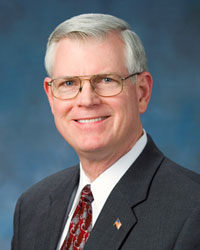
The safety engineers at NASA's Johnson Space Center invited me to speak to them this week about my post "What BP Can Learn from NASA." I spoke two days after the infamous well was finally, offically "bottom killed." Many in the audience knew a lot more about the situation than I do, since they are involved in the post-mortem investigation. I hope BP does learn from these savvy engineers, who have a lot to teach. After all, the NASA engineers learned much of it the hard way.
The audience listened attentively, but it was clear that they had other concerns. The weather was threatening, and it was still near the peak of hurricane season. Houston is still reeling from the evacuation influx from Katrina. Numerous billboards astride the interstate between Intercontinental airport and the Space Center remind Houstonians of their last chance to file claims from Ike.
JSC Director Michael Coats implored the safety engineers to be extra vigilant in the period of stress and uncertainty facing the center. Worried people are more prone to accidents, and with 1,800 layoffs looming between now and Christmas, JSC people have plenty to worry about. With worse than usual Washington budget bickering, Coats could not even offer his managers any guidance as to when their uncertainty might be resolved.

Michael Coats, Director, Johnson Space Center, former astronaut, NASA official portrait.
After my talk, I was treated to a VIP tour of the Space Center. I got to sit in some of the simulators where astronauts train and to see the live mission control centers for the shuttle and the International Space Station.

Apollo mission control in operation -- NASA photo
The emotional highlight for me was to go upstairs to the original Apollo mission control room, now preserved as a historical site. I sat in the chair where Chris Kraft and the crew of ground controllers agonized over the problems and celebrated the achievements. I saw the 1960-era switches and lights, dial telephones, pneumatic message tubes. I picked up a volume of laboriously detailed mission procedures. This is hallowed ground. It is as much a piece of American history as Boston's Old South Church, Constitution Hall, or the Gettysburg battlefield.
Unfortunately, Apollo mission control is on the third floor of a large, active building, in the middle of a secured campus. Perhaps someday NASA will be able to reconfigure the campus to make that building easy for the public to visit, and use the vast floor space that are computer rooms, conference rooms, and offices a definitive museum of the history of manned space exploration. Until then, hope you get offered a VIP tour.
JSC Director Coats spoke of the upcoming shuttle launch with more sadness than excitement. Before his career in industry and NASA senior management, he was an astronaut, logging three missions on the very shuttle now being prepped for its valendictory flight. He worries about the people whose jobs end with the mission.
The problems facing the manned space program are not the result of failure. Rather, they are the result of total success. President Kennedy committed America to be the first to land a man on the Moon and return him safely to Earth. It was the height of the Cold War -- times now so distant that those of us old enough to have lived through them scarcely remember the existential angst of imminent thermonuclear annihilation or the epic confrontation of ideological systems. Most Americans alive today had not yet even been born. The goal was of strictly geopolitical consequence: beat the Soviet Union in space and demonstrate to the people of the world the merits of democracy and an open society over tyranny and oppression.
It worked. We won. The race was over.
The manned space program program morphed from superpower competition to global collaboration. Most going to and coming back from space depends on Russian equipment: with the last shuttle launches that will be the only ride available to anyone for some time. Even the Russians can't stay in space without American ground control. American engineers learned to appreciate the mathematical and metalurgical prowess of their former adversaries; former Soviet engineers came to appreciate the pervasive impact of computers. It is a true international effort -- just like sci-fi fans expected, all along. And it, too, is a huge, if less celebrated, success.
While science fiction did not anticipate geopolitical prestige as the motivation for man-in-space, it does suggest other motivations: "To seek out new life ..." as Star Trek puts it; for the human species to survive some future global catastrophe; or just because it's there. All are good reasons, but none provide a rationale for "act now" urgency. Nor do they provide a goal near enough to fashion a program around but large enough to inspire political support to sustain a budget for years or decades.
The competitive phase of the manned space program succeded in beating the Soviet Union. The cooperative phase succeeded in helping the former Soviet Union join the world. Now what?
The manned space program still has not recovered from success. But it is important to permanently and effectively memoralize that success. And figure out how to move on. Houston, we have a problem.
The author serves on the JPL oversight committee of the Caltech Board of Trustees. Caltech operates JPL under a management contract with NASA. The views expressed are solely those of the author, and do not necessarily represent the views of Caltech, JPL, or NASA.